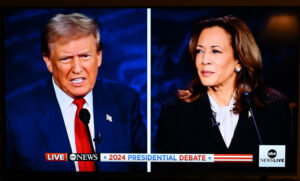The love affair that has blossomed between MAGA and the digital visionaries of Silicon Valley has left liberal pundits mystified. Why would America’s brainiest tech bros swipe right for Donald Trump? But it seems their love knows no bounds: yesterday, in the latest display of devotion, Trump droned on for two hours from Mar-a-Lago straight into the living rooms and laptops of his 90 million followers on X. The ostensible topic was his latest courtship of crypto, a new digital assets business venture called World Liberty Financial, which he rather vaguely outlined as a blockchain project that would link a newly created “$WLFI” stablecoin currency to the value of the United States dollar.
Decentralised finance would be the latest MAGA foray into Silicon Valley’s various and sundry roads to billions. First came Trump’s venture into nonfungible token digital trading cards (Trump as cowboy, Trump as astronaut, and now 50 new ones including Trump fondling Bitcoin); his eponymous cryptocurrency TrumpCoin (each of which is presently worth a shade above a cent — down 2% this past week); and of course his social media venture, Truth Social, which features an ever-plummeting stock price.
Three strikes and you’re out? Not for Trump, who’s swinging for Strike Four. There’s a pattern here, and it’s more than failure. There’s a political undercurrent to Trump’s venture into DeFi, one that has sent the commentariat into yet another bout of head-scratching.
The easy-bake explanation for Trump’s digital fascinations is that the matchmaker was J.D. Vance, the populist finance bro from Narya Capital who has made it clear that he has no taste for reining in tech monopolies. Others trace the tryst to Vance’s ex-boss, PayPal co-founder Peter Thiel, who has adored Trump ever since he descended the golden escalator in 2015. Those with more of a philosophical bent argue instead that power gravitates towards money and vice versa, and thus the mutual admiration society of the ex-most powerful man on the planet and the digitally richest man on the planet — Elon Musk, now rumoured to become bean-counter in chief of Trump presidency 2.0.
In a manner typical of this pragmatic approach to the odd coupling, the Financial Times suggested that the vibe between the smartest wonks in the room and the Alzheimer-adjacent egotist is simply a marriage of convenience — that tech entrepreneurs Marc Andreessen and Ben Horowitz are chasing lower tax burdens for their $42 billion VC firm, a16z. Not to neglect the pseudo-academics who cannot escape their self-imposed dungeons of political ideology, and thus take it for granted that the torrid affair is simply a matter of shared love and respect for libertarian values, which Trump supposedly shares with long-time MAGA acolyte, Tyler Winklevoss.
There may be something to the crypto connection, but not because of politics, libertarian or otherwise. “If we don’t do it, China is going to do it,” rambled Trump. “China is doing it anyway.” Which suggests that behind all the idiocies and get-rich-quickeries, perhaps there is an actual geopolitical strategy.
I came to this conclusion after stumbling across an obscure article reporting that the US Armed Services had “ramped up exploration of blockchain for military use”. A bit more research found that the United States House Armed Services Committee draft for fiscal year 2025’s National Defense Authorization Act did indeed include funding for potential applications of Bitcoin for their “Special Operations Command”.
It turns out the Pentagon’s legions of buzz-cut computer nerds are deep into conceptualising what has come to be called “Software-Defined Warfare” — that is, the belief that the next big conflict will resemble a massive computer game (at least, for those who work command-and-control from 18 stories beneath the bedrock of Arizona). Of course, the particular brand of software expertise required to emerge victorious from such a battle can only come from Silicon Valley, where those who were once called death merchants now work in the “commercial tech defense innovation space”.
All of which reminded me of a long-forgotten legal dispute involving Thiel, and one of the many companies he has co-founded — Palantir Technologies. (The name is taken from those communication and surveillance devices — that is, crystal balls — that J.R.R. Tolkien wrote about in his epic of bloody global warfare, The Lord of the Rings, a book that has turned out to be the ur-text for tech VCs.) The precise nature of Palantir’s software business was not widely understood until that case in 2016, when the firm won a ruling that allowed it to compete for an Army contract valued at more than $200 million, thus adding to the more than $150 million Department of Defense money Palantir had already banked. The cherry on top was the $2 million Palantir had received from a rather sinister sounding entity, “In-Q-Tel”, which happens to be the investment arm of the CIA.
Such facts outline the dirty little secret of the marriage of MAGA and Silicon Valley: their shared fascination with all things autocratic and military, from the epic battlefields of The Lord of the Rings to the Space Force Trump proudly signed into being as the stand-alone, sixth branch of the US military, replete with its uniform straight out of Star Trek wardrobe reject storage. It’s not that Trump actually wants to fight wars. He just wants to play dictator on TV. Not to mention the salient fact: there’s money in it.
That money is the driving force behind the Silicon-MAGA merger is not a matter of conjecture, but of economic history. During the Second World War, the Office of Scientific Research and Development spent $450 million on weapons research and development in an effort to destroy the Evil Empires of Germany and Japan by means of radar-directed bombers, anti-radar jammers and electronic-frequency telemetry. Silicon Valley took its modern form when, after the war, an engineer named Frederick Terman, ex-head of the super-top-secret Harvard Radio Research Lab, went west to become Dean of Stanford Engineering and kindle the flames of Spook Entrepreneurship. Those were the days when the invisible secret powers hell-bent on taking over the world were not a matter to be contemplated by conspiracy theorists, but by the mavens of “Signals Intelligence”.
Donald Trump, like Silicon Valley itself, is a child of the Cold War. He came of age as America’s cult of paranoia blossomed during the decade after the Second World War. It was perhaps inevitable that Fred Terman’s programme would double in size as the NSA, CIA, Navy and Air Force nestled into the verdant coast between San Francisco and San Jose. During the Korean War, Terman became Provost of Stanford’s School of Engineering, and made a fateful choice. He encouraged his students not to become academics but to consult for privately held companies, or else start companies themselves — greasing the wheels of entrepreneurship by allowing them to license his department’s intellectual property for free. Thus did Silicon Valley assume its modern form at the height of American reactionary culture, as the country suffered through Joseph McCarthy’s attack on the Deep State, a Civil Rights backlash, and an obsession with enemies domestic and abroad. In other words, precisely the themes that possess Donald Trump.
By the end of the Fifties, two brothers from Palo Alto, Russell and Sigurd Varian, had become so thoroughly wracked with anxiety about American weakness that they devised a method to use microwaves to detect tiny specks moving through the sky hundreds of miles distant, such as missiles and airplanes. The result was an extraordinarily complex device known as the klystron, in which the Sperry Corporation soon invested. The profits would transform Sperry into one of America’s most renowned defence contractors, the off-shoots of which would include Honeywell (makers of Chinook attack helicopters), Lockheed Martin (creators of the ATACM rockets), Raytheon Technologies (radars and mine-hunting sonar) and Northrop Grumman (fighter jets, stealth bombers). Each and every one from the Valley.
Needless to say, these companies and those that inevitably followed were not brimming with peace-loving, ankh-wearing hippies. The general ethos of authoritarianism encouraged the rise of those slide-rule junkies who were more often than not as combative and paranoid as Trump himself. The most MAGA-prophetic of them all was a Nobel-Prize winning Palo Alto native named William Shockley, who co-invented the solid-state transistor. Shockley Semiconductor was the first company to bring actual work on silicon semiconductors to Silicon Valley. Much like Donald Trump, Shockley lashed out in demented rage at any and all perceived enemies. But perhaps more to the point, he was a stupefyingly bad manager — domineering, erratic, paranoid, apt to change his mind at the last minute. Another problem: Shockley was a racist. When he entered the Republican primary for a California Senate seat in 1982, he publicly declared his policy solution to make America Great: those with an IQ of less than 100 should be sterilised.
While Shockley amassed less than 1% of the Republican primary vote, his influence on the tech world knew no bounds. Ex-Shockley employees would found more than five-dozen chip companies in the Bay Area, and many would catch the attention of the east coast financial establishment, thus igniting the first wave of West Coast Initial Public Offerings — Varian in 1956; Hewlett Packard in 1957; Ampex in 1958. By the end of the Fifties, the “Traitorous Eight” who had stormed out of Shockley Semiconductor had set a pattern of venture capital investment emulated to the present day. The greatest of their nascent west coast VC firms was Kleiner Perkins, which would eventually evolve into Sequoia Capital, which has not only bet much of its $85 billion on war technology, but publicly backed Trump last May.
It’s not only about the money. The traditional Menlo Park nerd possesses a particular personality profile that contains glimmers of your average MAGA dude. Like Donald Trump, Right-wing tech bros like to prattle on the airwaves, from “Thiel Talks” to “The Ben & Marc Show”. Early Facebook executive Chamath Palihapitiya co-hosts the Trump-coddling “All-In” podcast with South African venture capitalist David Sacks (angel investor in Airbnb, Uber and SpaceX), who also managed to elbow his way onto the speakers list at the Republican National Convention. Our stockpiles of weapons, Sacks declared “are dangerously depleted”. The solution was obvious: more weaponry, more investment.
Even as Sacks promoted Trump’s candidacy at the RNC, he was boosting his own investment in a start-up military drone-manufacturer called Anduril — and soon thereafter, potential backers flocked to fund the latest incarnation of Honeywell and Raytheon. By the time the RNC had nominated Trump, VCs had raised $1.5 billion for Anduril, presently valued at $14 billion.
It should come as no surprise that like Palantir, the name Anduril was inspired by The Lord of the Rings. Remember that sword that was reforged from the shards of Narsil by 11 smiths in Rivendell? Neither do I. But the nomenclature reiterates the fact that the wonks of Silicon Valley, like the fearful Manichaeists of MAGA, view the world as if it were Tolkien’s Middle Earth, a world brimming with invisible conspiracies and unimaginable riches, a world in which saying things can make them true, a world where dark-skinned immigrant Orcs battle white-skinned elves.
A fascination with global warfare has been a constant Trump trope, as since 2016 he has warned us again and again that we are hurtling towards “World War Three”. The coming apocalypse has endured as one of the mantras of his 2024 campaign, and once again the apocalyptic fascination strangely aligns with the ambitions of west coast digiterati, as Anduril’s co-founder, Brian Schimpf, has declared the global military theatre as a “constant threat environment”. It is no coincidence that Schimpf speaks in the same autocratic accents as Trump, declaring during a recent YouTube conversation that the way to peace and prosperity is not the democratic process, but to “just force change into the system”.
Perhaps Silicon Valley’s new generation, fed upon the milk and honey of video games, a global pandemic, and the business gospel of “move fast and break things” has grown comfortable with apocalyptic ideation. At the heart of their loathing of bureaucracy lies the infant boy’s infatuation with smashing any and all playthings. The bros have come to love the violence that lies at the source of their filthy lucre, no matter the cost. And so there should be no confusion as to why Silicon Valley loves MAGA and MAGA loves Silicon Valley: when each looks into the other’s eyes, they see themselves. To those spectrum-y engineers seduced by the epic nonsense of The Lord of the Rings and empowered by the rush of their own breathtaking economic superpowers, Donald Trump has become the ultimate fantasy: a crypto-president whose digital source code they might well soon possess.
Disclaimer
Some of the posts we share are controversial and we do not necessarily agree with them in the whole extend. Sometimes we agree with the content or part of it but we do not agree with the narration or language. Nevertheless we find them somehow interesting, valuable and/or informative or we share them, because we strongly believe in freedom of speech, free press and journalism. We strongly encourage you to have a critical approach to all the content, do your own research and analysis to build your own opinion.
We would be glad to have your feedback.
Source: UnHerd Read the original article here: https://unherd.com/





